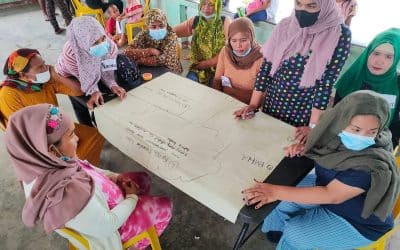InAsia
Insights and Analysis
Myanmar Democracy: Small Steps on a Long Journey
November 7, 2018
For decades, Myanmar was governed by a small military elite, accused of acting solely in their own interests. The introduction of a new constitution in 2008 was a dramatic and significant development, creating 14 new state and region governments and parliaments and the promise of democratic participation by a more diverse range of actors. At its heart, democratization in Myanmar means transforming a top-down, autocratic regime into a system that is responsive to the needs and aspirations of democratic constituencies at many levels—local, regional, and national—and establishing effective mechanisms of public administration to achieve them. The creation of the state and region governments thus marks the beginning of a process of decentralization with vast potential for greater participation by citizens and greater responsiveness to regional and local needs. On October 31, The Asia Foundation published a new edition of its flagship report, State and Region Governments in Myanmar, reflecting on five years of progress in Myanmar’s decentralization. The report finds both challenges ahead and grounds for cautious optimism, with encouraging signs of increasing accountability, responsiveness to local needs, and greater public participation in governance.

November 8, 2016. Outside NLD headquarters in Yangon, party supporters celebrated as preliminary results begin to spread on social media after polls closed on Election Day.
State and region governments that are accountable, participatory, and transparent can give people more power and influence over the laws and policies by which they are governed, deepening democracy in Myanmar. They can lead to more efficient and responsive public services and infrastructure in a country where economic growth has been slow. And they offer hope for an end to Myanmar’s long-running internal conflicts. While the system established by the 2008 Constitution will not be sufficient to establish a lasting peace, there is a consensus among signatories of the Nationwide Ceasefire Agreement that a future system will be based on some form of federalism. Decentralization can thus provide the building blocks for a future federal structure and give subnational actors the experience and capacity to govern democratically.
The positive effects of decentralization are not guaranteed, however. For decentralization to deliver these benefits, state and region governments must be both capable of, and accountable for, executing their greater responsibilities. The starting point for all actors in Myanmar’s subnational governance system must be an understanding of how the system works and where the opportunities and challenges lie. It is this understanding that the Foundation’s latest report seeks to strengthen. Arriving five years after the report’s first edition, it provides analysis of the key trends since the state and region governments’ creation and an opportunity to examine the issues that will shape the policymaking context for years to come.
Five years after the Foundation’s original report, it is clear that Myanmar’s 14 state and region governments are assuming more responsibility. They are increasingly taking the lead in identifying and addressing regional development priorities and are now making efforts to promote the rule of law, most noticeably in their work to resolve land-rights issues. Several have launched initiatives in new policy areas that respond to local needs.

The capitol in Nay Pyi Taw. Myanmar’s civilian government inherited a deficit of crucial administrative capacities, especially in the realm of policymaking, from five decades of military rule.
The growing importance of these subnational governments can be seen in two important developments. First, their budgets have grown to nearly three times their original size. Last year, state and region governments spent over USD 1.8 billion—an amount that guarantees influence. Second, government departments in the states and regions, although they are part of national ministries, are becoming more accountable to the state and region governments, increasing the involvement of state/region ministers in decision-making, coordination, planning and budgeting, and policymaking.
The 2008 Constitution also established parliaments in each of Myanmar’s states and regions. These parliaments have become important and diverse political forums, with 21 different political parties represented and close to one-third of elected seats held by regional or ethnic parties. The number of women MPs has tripled—an important development, though further progress is needed.

For more than five decades, government financial information was not accessible to the public in Myanmar. As a consequence, the majority of the people in the country are not familiar with the budget process, how priorities are determined, or how much the government spends.
Over the past five years, these parliaments have grown increasingly assertive in their oversight of their executive branches, particularly in some states and regions, such as Yangon and Rakhine, and in relation to certain issues, such as the annual budget. They have passed legislation with important implications for local people, and they have worked especially energetically with other government actors to ensure that the needs and concerns of their constituents are heard and addressed.
While the 2008 Constitution created the state/region governments and parliaments, it did not create a third tier of government below them. By default, this left in place the existing arrangements for local administration, limiting public participation and democratic accountability. Despite this, both the national and the state/region governments have worked to make local governance more participatory and responsive to local needs. The transitional government of the Union Solidarity and Development Party focused on increasing the role of local committees, fostering public participation, financing local development funds, and reforming the ward and village-tract administrator role, a critical conduit between local people and the state, to make it an elected position. Its successor, the National League for Democracy, has pursued greater participation and accountability by encouraging the involvement of state and region MPs in local affairs.
In spite of this significant progress, there are still substantial obstacles to an accountable, responsive, and participatory state in Myanmar. There is a need to build the capacity of all actors in the country’s subnational governance system, to ensure that government budgets direct spending where it is needed most, and to strengthen local governance in the absence of democratically elected local governments.
The Asia Foundation’s Myanmar Strategic Support Program, a collaboration with the Renaissance Institute funded by DFAT, DFID, and Swiss Development Cooperation, is working with state and region governments to address many of these challenges. Much of this work centers on government accountability, including support for the state/region Citizen’s Budgets and other transparency initiatives and helping those governments build their core capacities.
Regardless of the challenges ahead, over the past five years Myanmar’s state and region governments have demonstrated that they matter, that they can play a critical role in supporting Myanmar’s democratization, and that they can have a lasting impact on the lives of people across the country. Their importance will only continue to grow in the coming years.
A full copy of State and Region Governments in Myanmar can be found here.
Richard Batcheler is a researcher and policy analyst for The Asia Foundation in Myanmar, and the author of the latest edition of State and Region Governments in Myanmar. He can be reached at [email protected]. The views and opinions expressed here are those of the author, not those of The Asia Foundation.
1 Comment
About our blog, InAsia
InAsia is posted and distributed every other Wednesday evening, Pacific Time. If you have any questions, please send an email to [email protected].
Contact
For questions about InAsia, or for our cross-post and re-use policy, please send an email to [email protected].The Asia Foundation
465 California St., 9th Floor
San Francisco, CA 94104
The Latest Across Asia
News
April 25, 2024
Program Snapshot
April 18, 2024

2024 Lotus Leadership Awards
The Lotus Leadership Awards recognize contributions towards gender equality in Asia and the Pacific







The report technical approach on how decentralization could be carried out is an achievement and if given the appropriate political climate could be valuable.
But it dwells on the premises of constitutional amendment of the military-drafted constitution and not rewriting it anew, which is what the ethnic nationalities were originally for it but now toned down generally for amendment for whatever reason they may have in store.
The second thing is the issue of 14 State/Region and 8 State debate, which is still not resolved concerning the ethnic equality and the one-sided creation of 7 Division/Region by the Bamar military center and accepted by the Bamar political elite, as a forgone conclusion and given for granted.
The final one is the genuine political will to be equal from the part of the powers that is controlled by the Bamar military & political elite in relation to the non-Bamar ethnic nationalities. In other words, establishing a genuine federal union that could be accepted by all and not imposed by the Bamar center.